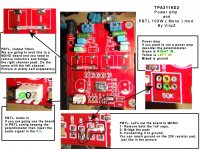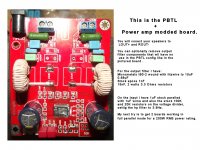If you want even less noise, try reduce the gain. The amp is currently at 26 db. As you mentioned in your post, your HF driver is really sensitive, even 20 db of gain might work well.
Regards,
yes, I've enough headroom there, as I had to drop the level on the miniDSP config by 2.5 dB as part of matching it to the other amp.
Some but not all of the hiss is removed by dropping the input volume control to zero, so a portion of it is from the source - which I guess explains the t2 being quieter as it has obviously less gain.
Some further listening and I think there is some difference between this amp and the T2 in sound, but cant really put my finger on it, so far quite close!
I have about 7.5 dB attenuation on the HF in the miniDSP config to here, so sounds like I could get it quieter.
praise the lord!!!!
i got the pbtl-mode running.
i somehow wrecked the 20k-smd-resistor on the input side while soldering a bridge to it.
my unbelievable soldering skills make it possible to transform a 20k resistor into 1,5M.
Hi can you do the same trick with caps ?
yes, I've enough headroom there, as I had to drop the level on the miniDSP config by 2.5 dB as part of matching it to the other amp.
Some but not all of the hiss is removed by dropping the input volume control to zero, so a portion of it is from the source - which I guess explains the t2 being quieter as it has obviously less gain.
Some further listening and I think there is some difference between this amp and the T2 in sound, but cant really put my finger on it, so far quite close!
I have about 7.5 dB attenuation on the HF in the miniDSP config to here, so sounds like I could get it quieter.
I would suggest for drivers of such high sensitivity to use batteries instead of the smps for a lower noise floor. You could even use a 9v battery to test and compare since the TPA is usable down to 4.5v(?). You don't need 24v for your setup. 12v will be plenty for 103db speaker.
Last edited:
I'm gonna build a very simple and small class D amp, and I'm almost certainly gonna use this TPA3116, on the Yuan Jing board.
Yuan Jing Audio - ON SALE! - TPA3116 Class-D Stereo Amplifier Board [50W+50W] - $13.99
Are there any (quality) problems with this board?
I'm almost sure i'm going to use the tpa3116, but there's a quite cheap TK2050 board available too and I like the reviews saying that the Tripath is 'tube-like sounding' and has a very 'airy' top end. Those are two things I really really like in an amplifier (also, I don't care about datasheet numbers, as long as it sounds good).
Any opinions (why shouldn't I buy the tripath)?
Thanks
Yuan Jing Audio - ON SALE! - TPA3116 Class-D Stereo Amplifier Board [50W+50W] - $13.99
Are there any (quality) problems with this board?
I'm almost sure i'm going to use the tpa3116, but there's a quite cheap TK2050 board available too and I like the reviews saying that the Tripath is 'tube-like sounding' and has a very 'airy' top end. Those are two things I really really like in an amplifier (also, I don't care about datasheet numbers, as long as it sounds good).
Any opinions (why shouldn't I buy the tripath)?
Thanks
I'm gonna build a very simple and small class D amp, and I'm almost certainly gonna use this TPA3116, on the Yuan Jing board.
Yuan Jing Audio - ON SALE! - TPA3116 Class-D Stereo Amplifier Board [50W+50W] - $13.99
Are there any (quality) problems with this board?
I'm almost sure i'm going to use the tpa3116, but there's a quite cheap TK2050 board available too and I like the reviews saying that the Tripath is 'tube-like sounding' and has a very 'airy' top end. Those are two things I really really like in an amplifier (also, I don't care about datasheet numbers, as long as it sounds good).
Any opinions (why shouldn't I buy the tripath)?
Thanks
because the TK 2050 does not sound especially tube like compare to the TPA 3116. The TP a amplifier sounds much better and the tube like comparisons for the TK 2050 are from years ago when they were more competitive. I consider the TPA amplifiers to be far more tube like in sound than the TK 2050 not to mention just plain better in terms of sound quality and usable with batteries which also allows improved sound quality possibilities versus the TK 2050.
Hi guys, just a we question regarding signal input voltage, what is the right for of voltage for these tpa3116? Data sheets says INPL, INNL, INPR, INNR –0.3 to 6.3, 6.3 seems high to common levels, perhaps I'm not understanding this correctly? For eg I know the old ta2020s I have can only take 2v. I have a couple of these yuan jing stereo boards and am wondering what voltage I should look for when matching source hardware to it.
These are the maximum voltages that can be applied to the device without causing damage as detailed in the footnote:-Hi guys, just a we question regarding signal input voltage, what is the right for of voltage for these tpa3116? Data sheets says INPL, INNL, INPR, INNR –0.3 to 6.3, 6.3 seems high to common levels, perhaps I'm not understanding this correctly? For eg I know the old ta2020s I have can only take 2v. I have a couple of these yuan jing stereo boards and am wondering what voltage I should look for when matching source hardware to it.
(1) Stresses beyond those listed under absolute maximum ratings may cause permanent damage to the device. These are stress ratings
only, and functional operation of the device at these or any other conditions beyond those indicated under recommended operating
conditions is not implied. Exposure to absolute-maximum-rated conditions for extended periods may affect device reliability.
As the device is AC coupled to the source, no external DC is applied to these pins, thus it is of no consequence to the user. It is not the input sensitivity which is determined by the gain setting resistors. The default gain setting on mine was 26dB, but can be changed according to the data sheet Table 2, to 20, 32 or 36dB, by changing the resistors.
As far as I can tell the required input level is about the same as a TA2020 so if you can drive one of those adequately then there should be no problem with the TPA3116.
Leave the volume control in place and use it as a pre-set if there is too much gain unless you are using very sensitive speakers that produce too much noise with no signal.
PsychoM,
I own both a Sure based around the TK2050 and the subject TPA3116 amp. Although the Sure is good, I find the 3116 better in two ways: bass accuracy and details are presented with greater transparency.
I agree with Wushuliu's findings.
Thanks, that makes it clear: TPA3116 it is!
I haven't been here in a few days and there has been quite a bit of activity! On my amp I found out that the hiss can be reduced by tying an earth ground from the board to earth ground on AC wall plug and chassis of preamp. This will work best with a SMPS that has a ground plug. Some are only 2 prong input. In any case, the grounding of the board and the source seems to help a lot.
John, my board originally has a 4700uF 50v. Should i get 5600 uF 50V or 35V? What's the theoretical difference? I already have some panasonic FC 5600 uF 25V. Can i use them here instead?The only changes I have done is to the capacitor mentioned above for the sync. and adding an extra 5600µF 35V across the power supply which I notice is already fitted to your board.
Will there be any problems if i swap in the 5600 uF 25V here instead?I will change the 3 electrolytics across the power supply, 1000µF 25V, to Panasonic 1200µF 35V parts as the original ones are running a bit close to the 24V power supply for comfort. I was limited for height so 1200µF was the largest I could accommodate in the case.
Thank you, John
John, my board originally has a 4700uF 50v. Should i get 5600 uF 50V or 35V? What's the theoretical difference? I already have some panasonic FC 5600 uF 25V. Can i use them here instead?
Will there be any problems if i swap in the 5600 uF 25V here instead?
Thank you, John
If you are running with a 24V supply then I would not recommend 25V capacitors. 35V ones give a safety margin on working voltage which makes for a longer working life as the capacitor is less stressed.
I would be tempted to leave the 4700µF 50V as it is. If it ain't broke, don't fix it!! I can't see the extra capacitance giving a noticeable improvement if your power supply is capable of handling the peak current demand.
The only reason I used a 5600µF 35V was that I had a brand new low profile one in my spares box and the 2.1 board that I used did not have a bulk decoupling capacitor at all. (It worked quite well without it but the supply voltage dipped on bass peaks)
Has anyone removed the volume pot? I don't really need it, cause the volume control is on the pre-amp. So I would remove it if that helps to have a better sound quality.
Yeah, KJA did that way back when. He use a sliding volume control on one of his amp now.
Regards,
I haven't been here in a few days and there has been quite a bit of activity! On my amp I found out that the hiss can be reduced by tying an earth ground from the board to earth ground on AC wall plug and chassis of preamp. This will work best with a SMPS that has a ground plug. Some are only 2 prong input. In any case, the grounding of the board and the source seems to help a lot.
Yeah, I was always wondering about that - the ground of the board is not connecting to the power supply gorund (I did look and could not find any connection). Correct me if I am wrong.
Regards,
The TPA31xx series parts take a max of 30V, suggested 10-28VDC, so a 35V min cap V is recommended to have a bit of safety/reliability margin in a well designed unit. Nichicon PW,KL series or even Elna SilmicII would work fine. I am sure there are many others as well, for that you need to test/compare.
I run the TPA31xx series with minimum gain setting and make up the gain in the previous stage(s). THD/noise is probably lower and allows for a cheaper or higher performing i/p, balance bypass coupling cap.
Rick
I run the TPA31xx series with minimum gain setting and make up the gain in the previous stage(s). THD/noise is probably lower and allows for a cheaper or higher performing i/p, balance bypass coupling cap.
Rick
I have seem many requests on how to put the tpa3116D2 to work in PBTL and so there you go.
Having in mind that with this board we don't have the proper reference for components I am open to any questions you may have.
Having in mind that with this board we don't have the proper reference for components I am open to any questions you may have.
Attachments
- Home
- Amplifiers
- Class D
- TPA3116D2 Amp

